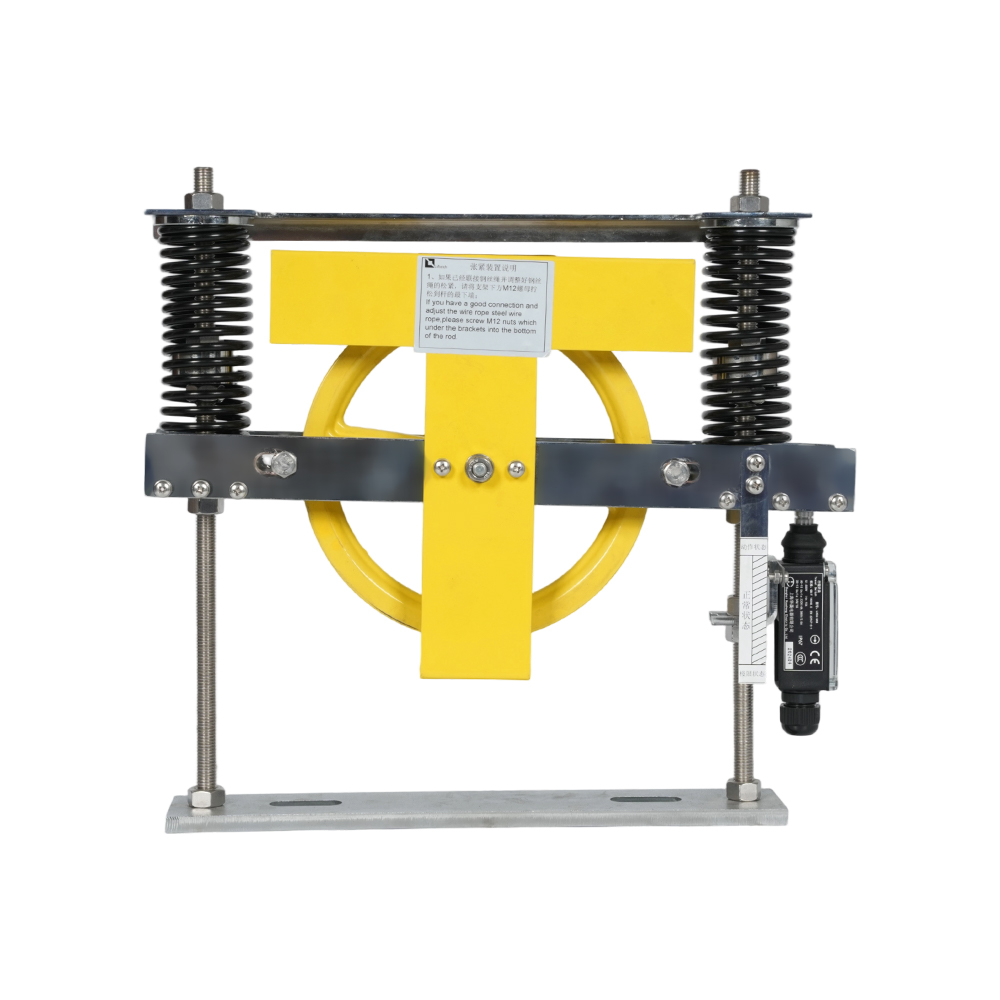Comprehensive Guide to Elevator Tension Device Parts: Components, Applications, and Maintenance Insights
Introduction: The Importance of Elevator Tension Device Parts
Elevator systems are critical components in modern buildings, ensuring the safe and efficient vertical transportation of people and goods. Among the many integral elements, elevator tension device parts play a pivotal role in maintaining system stability and operational safety. These components, which include tension pulleys, wire rope tensioners, buffer springs, and guide shoes, are responsible for managing the correct tension in elevator ropes, absorbing shocks, and guiding the elevator car along its path.
Proper functioning of tension device parts not only enhances the longevity of the elevator system but also prevents potential malfunctions that could compromise passenger safety. In industrial and high-rise applications, where elevators operate continuously under significant loads, the quality and maintenance of tension device components become even more critical.
Overview of Elevator Tension Device Components
Elevator tension devices consist of several core and auxiliary components, each contributing to the proper functioning and safety of the elevator system. Understanding these parts is essential for both manufacturers and maintenance personnel.
Core Components
- Tension Pulley: Maintains proper tension in the elevator wire ropes, ensuring smooth movement and minimizing wear.
- Wire Rope Tensioner: Adjusts rope tension automatically to compensate for load changes, reducing mechanical stress on the system.
- Buffer Spring Parts: Absorb shocks and provide cushioning during emergency braking or sudden stops, enhancing passenger safety.
- Safety Gear Assembly: Engages in emergency situations to stop the elevator car, preventing accidents.
Auxiliary Components
- Guide Shoes: Ensure the elevator car moves smoothly along the guide rails, reducing lateral movement.
- Traction System Accessories: Support the primary traction system, improving overall stability and efficiency.
Elevator Tension Device Parts and Functions
| Component | Function | Application |
|---|---|---|
| Tension Pulley | Maintains wire rope tension | All types of traction elevators |
| Wire Rope Tensioner | Adjusts tension automatically | High-rise and industrial elevators |
| Buffer Spring | Absorbs shock | Safety systems |
| Safety Gear Assembly | Emergency braking | All traction elevators |
| Guide Shoe | Guides elevator car | Low-speed and mid-speed elevators |
Types of Elevator Tension Devices
Elevator tension devices are primarily categorized into mechanical and hydraulic types, each with distinct operating mechanisms and applications. Understanding these types is essential for selecting the right system based on elevator load, speed, and operational environment.
Mechanical Tension Devices
Mechanical tension devices use springs or other elastic components to maintain wire rope tension. These systems are relatively simple, durable, and require minimal maintenance. They are commonly used in mid-rise elevators and industrial applications where reliability and cost-efficiency are important.
Advantages of mechanical tension devices:
- Simple design and easy installation
- Low maintenance requirements
- High durability under standard operating conditions
Hydraulic Tension Devices
Hydraulic tension devices use fluid pressure to adjust and maintain rope tension. These systems provide smoother operation and more precise tension control, making them suitable for high-rise elevators and applications with variable loads.
Advantages of hydraulic tension devices:
- Smooth and adjustable operation
- Suitable for high-rise and high-speed elevators
- Reduces mechanical wear on ropes and pulleys
Comparison of Mechanical and Hydraulic Tension Devices
| Type | Mechanism | Advantages | Typical Application |
|---|---|---|---|
| Mechanical | Spring-based | Low maintenance, durable | Mid-rise and industrial elevators |
| Hydraulic | Fluid-based | Smooth operation, adjustable | High-rise and high-speed elevators |
Both mechanical and hydraulic tension devices have their own strengths, and the choice depends on factors such as elevator height, load capacity, and frequency of operation. Selecting the right type ensures optimal performance, safety, and longevity of the elevator system.
Manufacturing and Material Considerations
The performance and durability of elevator tension device parts heavily depend on the materials used and the precision of manufacturing processes. Selecting high-quality materials ensures long-lasting operation, reduces maintenance frequency, and improves safety.
Material Selection
- Wire Ropes: Typically made of high-strength alloy steel to withstand significant tensile forces and minimize elongation over time.
- Sheaves and Pulleys: Often constructed from cast iron or steel with wear-resistant coatings to maintain smooth rope movement and reduce abrasion.
- Buffer Springs: Made from spring steel to provide consistent elasticity and absorb impact efficiently.
- Guide Shoes: Frequently manufactured from stainless steel or low-friction polymer to resist corrosion and reduce noise during operation.
Manufacturing Considerations
- Precision Machining: Ensures components fit perfectly within the tension system, reducing mechanical stress and wear.
- Surface Treatment: Coatings, heat treatments, and polishing improve durability and reduce friction.
- Compliance with Standards: Following international safety and engineering standards is critical to guarantee reliability and passenger safety.
Common Materials and Their Properties
| Material | Component | Key Property | Benefit |
|---|---|---|---|
| Alloy Steel | Wire Rope | High tensile strength | Long-lasting tension and minimal elongation |
| Cast Iron | Sheave | Wear resistance | Smooth operation and durability |
| Spring Steel | Buffer Spring | Elasticity | Efficient shock absorption |
| Stainless Steel | Guide Shoes | Corrosion resistance | Low maintenance and long service life |
Proper material selection and precise manufacturing processes directly impact the safety, reliability, and efficiency of elevator tension device parts. Companies investing in high-quality materials and rigorous quality control are better equipped to provide durable solutions for various elevator applications.
Applications of Elevator Tension Device Parts
Elevator tension device parts are essential in a wide range of elevator systems, from commercial buildings to industrial and residential applications. Their functionality directly affects the safety, reliability, and performance of the entire system.
Commercial Elevators
In commercial high-rise buildings, elevators operate continuously under heavy loads. Components such as tension pulleys, wire rope tensioners, and buffer springs are critical to maintaining smooth and safe operation. Custom elevator wire rope tensioner components are often used to adapt to varying building heights and traffic patterns, ensuring consistent performance.
Industrial Elevators
Industrial elevators, which transport goods or heavy equipment, require robust and durable tension device parts. Industrial elevator tension pulley spare parts are designed to withstand high-frequency operation and heavier loads. In these settings, durability and precision are prioritized over cost, making high-quality components essential.
Residential and Low-Rise Elevators
Even in smaller residential buildings, elevator tension device parts play a significant role. Mechanical tension adjustment systems ensure the elevator car moves smoothly and quietly, providing comfort and safety for occupants. Properly designed and maintained components reduce wear and extend the life of the system, minimizing maintenance costs over time.
Elevator Applications and Recommended Tension Device Parts
| Elevator Type | Recommended Parts | Key Considerations |
|---|---|---|
| Commercial High-Rise | Wire Rope Tensioner, Tension Pulley, Safety Gear | Continuous operation, high load capacity |
| Industrial | Industrial Tension Pulley, Buffer Spring, Sheave Components | Heavy-duty operation, durability |
| Residential / Low-Rise | Mechanical Tension Adjustment, Guide Shoes | Smooth movement, low noise, low maintenance |
By selecting appropriate tension device parts tailored to specific elevator applications, operators can optimize performance, ensure safety, and extend the operational lifespan of their elevator systems.
Maintenance, Troubleshooting, and Upgrades
Regular maintenance and timely troubleshooting of elevator tension device parts are essential to ensure safe operation and prevent unexpected downtime. Well-maintained components not only extend the life of the elevator system but also improve efficiency and reliability.
Routine Maintenance
- Inspection: Regularly check tension pulleys, wire rope tensioners, and buffer springs for wear, corrosion, or misalignment.
- Lubrication: Apply appropriate lubricants to moving parts, such as sheaves and guide shoes, to reduce friction and wear.
- Adjustment: Ensure mechanical tension adjustment systems maintain proper rope tension for smooth operation.
Troubleshooting Common Issues
Common Component Issues and Recommended Solutions
| Component | Common Issue | Recommended Solution |
|---|---|---|
| Tension Pulley | Uneven tension or rope slipping | Adjust alignment or replace pulley |
| Wire Rope Tensioner | Inconsistent tension | Inspect and recalibrate or replace tensioner |
| Buffer Spring | Weak rebound or fatigue | Replace spring with a new high-quality component |
| Safety Gear Assembly | Failure to engage | Conduct full inspection and repair as needed |
| Guide Shoe | Excessive friction or wear | Lubricate or replace worn shoe |
Upgrades and Optimization
- Advanced Materials: Upgrading to high-strength alloys or corrosion-resistant materials improves durability.
- Automated Monitoring: Integrating sensors and monitoring systems allows real-time detection of tension irregularities, enabling predictive maintenance.
- Customized Components: Using custom elevator wire rope tensioner components or industrial elevator tension pulley spare parts can optimize performance for specific applications.
Proper maintenance routines, prompt troubleshooting, and adoption of modern upgrades enhance safety, reduce operational costs, and extend the overall lifespan of tension device parts.
Future Trends in Elevator Tension Device Technology
As elevator systems evolve, tension device technology is also advancing to meet higher performance, safety, and efficiency standards. Emerging trends focus on automation, smart monitoring, and the use of innovative materials.
Intelligent Monitoring Systems
Modern elevators increasingly incorporate sensors and IoT-enabled devices to monitor tension device parts in real time. These systems detect irregularities in tension, wear, or alignment, allowing predictive maintenance before failures occur. Automated alerts reduce downtime and enhance passenger safety.
Advanced Materials
New materials are being applied to elevator tension device components to improve durability, reduce weight, and enhance corrosion resistance. High-strength alloys, polymer composites, and surface-treated metals extend the lifespan of parts such as sheaves, wire rope tensioners, and guide shoes, especially in harsh operational environments.
Energy Efficiency and Performance Optimization
Innovations in tension device design aim to reduce energy consumption and improve mechanical efficiency. Smooth-operating tension pulleys and optimized spring systems reduce friction losses, lowering power requirements for elevator traction systems. Customized components, including industrial elevator tension pulley spare parts, allow precise adaptation to specific load and speed conditions, maximizing performance.
Automation and Smart Adjustments
Automated mechanical tension adjustment systems are becoming more prevalent. These systems dynamically adjust wire rope tension based on load and operational conditions, improving ride quality and reducing stress on mechanical components. Combined with smart monitoring, these systems represent the next generation of elevator tension device technology.
Conclusion
Elevator tension device parts are essential components that ensure the safety, efficiency, and reliability of modern elevator systems. From tension pulleys and wire rope tensioners to buffer springs and guide shoes, each component plays a critical role in maintaining proper rope tension, absorbing shocks, and guiding the elevator car along its rails. Understanding the functionality, material selection, and maintenance requirements of these components is vital for operators, manufacturers, and maintenance personnel.
Selecting the right type of tension device—mechanical or hydraulic—depends on the application, load requirements, and operational environment. Proper maintenance routines, timely troubleshooting, and the use of high-quality materials significantly extend the lifespan of tension device parts while minimizing downtime and operational risks. Additionally, adopting advanced technologies, including smart monitoring systems, automated tension adjustments, and innovative materials, can enhance performance, energy efficiency, and safety.
The applications of elevator tension device parts span commercial, industrial, and residential elevators, with each requiring components tailored to specific operational needs. By integrating modern trends and high-quality components, elevator operators can ensure smooth, reliable, and safe vertical transportation for passengers and goods.
A comprehensive understanding of elevator tension device parts—combined with informed maintenance practices and adoption of emerging technologies—provides a foundation for optimizing elevator performance.


 English
English 中文简体
中文简体 русский
русский Español
Español Deutsch
Deutsch








